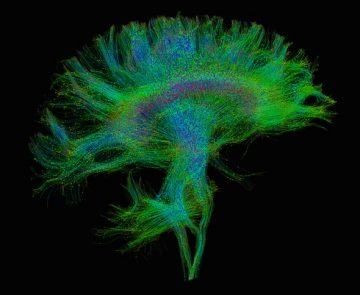Michele Solis in Scientific American:
 What makes the human brain special? That question is not easy to answer—and will occupy neuroscientists for generations to come. But a few tentative responses can already be mustered. The organ is certainly bigger than expected for our body size. And it has its own specialized areas—one of which is devoted to processing language. In recent years, brain scans have started to show that the particular way neurons connect to one another is also part of the story. A key tool in these studies is magnetic resonance imaging (MRI)—in particular, a version known as diffusion tensor imaging. This technique can visualize the long fibers that extend out from neurons and link brain regions without having to remove a piece of skull. Like wires, these connections carry electrical information between neurons. And the aggregate of all these links, also known as a connectome, can provide clues about how the brain processes information.
What makes the human brain special? That question is not easy to answer—and will occupy neuroscientists for generations to come. But a few tentative responses can already be mustered. The organ is certainly bigger than expected for our body size. And it has its own specialized areas—one of which is devoted to processing language. In recent years, brain scans have started to show that the particular way neurons connect to one another is also part of the story. A key tool in these studies is magnetic resonance imaging (MRI)—in particular, a version known as diffusion tensor imaging. This technique can visualize the long fibers that extend out from neurons and link brain regions without having to remove a piece of skull. Like wires, these connections carry electrical information between neurons. And the aggregate of all these links, also known as a connectome, can provide clues about how the brain processes information.
A persistent question about connectomes has to do with what, if anything, distinctive wiring patterns have to do with the evident cognitive differences in a mouse, a monkey or a human. A new methodology called comparative connectomics has identified some general rules of brain wiring across species that may help provide answers. In the meantime, it has also found some unique facets of the human connectome and discovered changes in the cells charged with the upkeep of brain wiring. Together these evolutionary innovations seem to keep information flowing efficiently through a large human brain. And when they are disrupted, they may give rise to psychiatric disorders.
More here.
